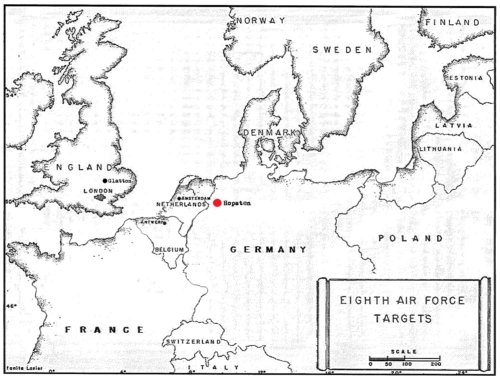On this date, March 24th, 1945, the 457th flew two missions. One mission of 36 aircraft was in the morning and flew to the target of Hopsten, Germany. The afternoon mission of 12 aircraft joined with the 351st Bomb Group and flew to the target at Twente / Enschede, Germany.
We have included both missions on this page and the loading list includes all crews that flew a mission on this date.
TARGET: GERMAN TROOPS
HOPSTEN, GERMANY
24 MARCH, 1945
“Morning Mission”

The ground war was now being fought on German soil. The Western Front was on the west side of the Rhine River. All that was needed was some bombing on the east side of the river to soften up the resistance. This day the Eighth provided that support by sending bombers up and down the river in an all day assault.
The 457th comprised the 94th C Combat Wing, providing thirty-six aircraft to bomb Hopsten, with Lt. Colonel Francis as Air Commander, in the morning. The Group provided twelve craft to comprise the 94th low A box in the afternoon. It would be another “max effort” on the part of the Eighth Air Force and the 457th. The morning mission takeoff was at 1017 hours.
The Group assembled at 6,000 feet and was late in assembling because of a late takeoff by some aircraft, but did assemble in Wing formation on time and on course. Deviations to the left of course along the Division assembly line were necessary in order to remain in Division column. The Group came back on course and flew the remainder of the route to the IP as briefed.
Bombing was visual with squadrons in trail. About half way down the bomb run, the Group lead aircraft was hit by antiaircraft fire, which knocked out the electrical system and rendered the bombsight inoperative.
Lead was turned over to the deputy aircraft, but after a short interval, it was also hit, which knocked out the VHF and wounded the radio operator. The bombardier was not able to sight on the target, so the formation proceeded to Plantlunne, the secondary target.
The bomb pattern was largely scattered, because of confusion caused by antiaircraft fire. The low squadron lead aircraft was hit by flak and had to leave the formation. The lead was taken over by the deputy who, with the remainder of the squadron, bombed the primary target, Hopsten Airfield. Bombs were released at 25,000 feet. Bombing results were observed to be fair to good. Twenty-three planes sustained damage.
Lt. Sherrill R. Williams and crew were flying Mission No. 20. Lt. Williams had one constant habit on missions; he had one of his infant daughter’s shoes and penned the name of the target on the shoe. At 21,000 feet, Lt. Williams was in position as the Group swung on the bomb run. Bomb bay doors were opened.
Then there was a flak burst. Antiaircraft fire tore into the right wing. Nine feet of the wing was torn away by the explosion. The aircraft left the formation, turned over on its back and was out of control breaking in half at the radio room. Three of the crew survived. Lt. Williams was not among those three.
